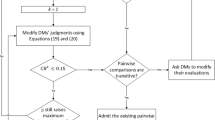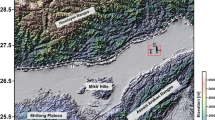Abstract
Candidate-well selection (CWS) aims to recognize wells that have potential for higher production after hydraulic fracturing stimulation in petroleum development process, which is natural nonlinear, strong-coupling, uncertain, multi-input, and single-output mathematical problem. CWS hybrid intelligence model is developed by integrating widely applied fuzzy logic systems (FLS), namely, type-2 Takagi-Sugeno-Kang (T2-TSK) FLS, with grey clustering analysis (GCA) for hydraulic fracturing in H gas field of Sichuan Basin, one of the large natural gas field in Southwest of China. The T2-TSK FLS is constructed based on field data involving 49 fractured wells, while the GCA is used to determine the dominant input variables data, and these dominant variables have great influence on post-fractured production. Then we use 39 fractured wells data to train the T1-TSK and T2-TSK FLS to predict post-fractured production. The accuracy of the trained models is validated by comparing predicted post-fractured production with real post-fractured production for the rest of the 10 fractured wells. The evaluation results for the gas field case demonstrate that the T2-TSK FLS is superior to the traditional T1-TSK FLS for CWS using the same input data. The T2-TSK FLS developed in this paper gives high accuracy predicted post-production in H gas field, which is very helpful in selecting the candidate well exactly for hydraulic fracturing.







Similar content being viewed by others
References
Al-Mudhafer WJM, Alabbas M (2012) Application of a hybrid system of genetic algorithm & fuzzy logic as optimization techniques for improving oil recovery in a sandstone reservoir in Iraq. Soc Petrol Eng. https://doi.org/10.2118/149982-MS
Anifowose F, Abdulraheem A (2011) Fuzzy logic-driven and SVM-driven hybrid computational intelligence models applied to oil and gas reservoir characterization. J Nat Gas Sci Eng 3(3):505–517
Anifowose F, Labadin J, Abdulraheem A (2013) A least-square-driven functional networks type-2 fuzzy logic hybrid model for efficient petroleum reservoir properties prediction. Neural Comput & Applic 23:179–190. https://doi.org/10.1007/s00521-012-1298-2
Barree RD, Miskimins JL, Svatek KJ (2018) Reservoir and completion considerations for the refracturing of horizontal wells. SPE Prod Operations 33(01):1–11
Barrett JD (2007) Advanced fuzzy logic technologies in industrial applications. Springer London, 494-495
Castillo O and Melin P (2012) Type-2 fuzzy logic systems. Springer Berlin Heidelberg, 7-12
Cheng K, Wei Y, Wu W and Holditch SA (2010) A novel optimization model for analyzing production data. Society of Petroleum Engineers
Crowell RF and Jennings AR (1978) A diagnostic technique for restimulation candidate selection, SPE Annual Fall Technical Conference and Exhibition. Society of Petroleum Engineers
Deng JL (1989) Introduction to grey system theory. J Grey Syst 1(1):1–24
East L, Craie D (2006) Refracs reverse production dips. Hart’s E & P 79(11):45–47
Grieser WV, Shelley RF, Johnson BJ, Fielder EO, Heinze JR, Werline JR (2008) Data analysis of Barnett shale completions. SPE J 13(03):366–374
Guo J, Xiao Y, Zhu H (2014) A new method for fracturing wells reservoir evaluation in fractured gas reservoir. Math Probl Eng:2014
Khan WA, Sudirman SB, Qahtani GD (2017) Integrating field performance and history matching uncertainties using fuzzy logic to minimize well-placement risks. Soc Petrol Eng. https://doi.org/10.2118/187986-MS
Khosravanian R, Sabah M, Wood DA, Shahryari A (2016) Weight on drill bit prediction models: Sugeno-type and Mamdani-type fuzzy inference systems compared. J Nat Gas Sci Eng 36:280–297
Klir GJ, Yuan B (1995) Fuzzy sets and fuzzy logic: theory and applications. Int Encycl Human Geogr:283–287
Kong L, Ostadhassan M, Tamimi N, Samani S, Li C (2019) Refracturing: well selection, treatment design, and lessons learned—a review. Arab J Geosci 12:117
Krasey R (1988) High grading fracture candidate selection. J Can Pet Technol 27(04):50–54
Lantz TG, Greene DT, Eberhard MJ, Norrid RS and Pershall RA (2007) Refracture treatments proving successful in horizontal Bakken wells; Richland Co, MT, Rocky Mountain Oil & Gas Technology Symposium. Society of Petroleum Engineers
Ma X, Sun Z, He Y (1998) Analysis and design of fuzzy controller and fuzzy observer. Fuzzy Syst IEEE Trans 6(1):41–51
McVey DS, Mohaghegh S (1996) Identification of parameters influencing the response of gas storage wells to hydraulic fracturing with the aid of a neural network. SPE Comput Appl 8(02):54–57
Mendel JM (2007) Type-2 fuzzy sets and systems: an overview. IEEE Comput Intell Mag 2(1):20–29
Mohaghegh S, Reeves S and Hill D (2000) Development of an intelligent systems approach for restimulation candidate selection, SPE/CERI Gas Technology Symposium. Society of Petroleum Engineers
Mohaghegh SD, Gaskari R, Popa AS, Salehi IA, Ameri S (2005) Analysis of best hydraulic fracturing practices in the golden trend fields of Oklahoma. Soc Petrol Eng. https://doi.org/10.2118/95942-MS
Okwu MO, Nwachukwu AN (2019) A review of fuzzy logic applications in petroleum exploration, production and distribution operations. J Pet Explor Prod Technol 9:1555–1568. https://doi.org/10.1007/s13202-018-0560-2
Papadakis SE, Theocharis JB (2002) A GA-based fuzzy modeling approach for generating TSK models. Fuzzy Sets Syst 131(2):121–152
Reeves SR et al (1999) Restimulation of tight gas sand wells in the Rocky Mountain region, SPE Rocky Mountain regional meeting, 361-374
Reeves SR et al (2000) Benchmarking of restimulation candidate selection techniques in layered, tight gas sand formations using reservoir simulation, SPE Annual Technical Conference and Exhibition. Society of Petroleum Engineers
Ren Q, Balazinski M, Baron L, Jemielniak K, Botez R, Achiche S (2014) Type-2 fuzzy tool condition monitoring system based on acoustic emission in micromilling. Inf Sci 255(1):121–134
Rui Z, Guo T, Feng Q, Zhanqing Q, Qi N, Gong F (2018) Influence of gravel on the propagation pattern of hydraulic fracture in the glutenite reservoir. J Petrol Sci Eng 165:627–639
Shen B and Zhang Y (2013) “Grey correlation analysis of tropical cyclone landing time,” 2013 Fourth International Conference on Digital Manufacturing & Automation, Qingdao, pp. 641-644, https://doi.org/10.1109/ICDMA.2013.152
Shi T, Jiang W, Luo P (2018) A method of clustering ensemble based on grey relation analysis. Wirel Pers Commun 103:871–885. https://doi.org/10.1007/s11277-018-5484-0
Smith MB (2006) Hydraulic fracturing: “THE” Multidisciplinary Technology
Sugeno M, Kang GT (1988) Structure identification of fuzzy model. Fuzzy Sets Syst 28(1):15–33
Takagi T, Sugeno M (1985) Fuzzy identification of systems and its applications to modeling and control. Syst Man Cybernet IEEE Trans 1:116–132
Tsai M, Hsu F (2010) Application of grey correlation analysis in evolutionary programming for distribution system feeder reconfiguration. IEEE Trans Power Syst Pwrs 25(2):1126–1133
Wang Y, Salehi S (2014) Refracture candidate selection using hybrid simulation with neural network and data analysis techniques. J Pet Sci Eng 123:138–146
Witten IH, Frank E (2005) Data mining: practical machine learning tools and techniques. Biomed Eng Online 5 51(1):95–97
Xiang-jun X and Ting Y (2014) Application of T-S fuzzy model in candidate-well selection for hydraulic fracturing. Fuzzy Information & Engineering and Operations Research & Management. Springer, 563-570
Xiao Y, Guo J and Songgen S (2015) A comparison study of utilizing optimization algorithms and fuzzy logic for candidate-well selection, SPE/IATMI Asia Pacific Oil & Gas Conference and Exhibition. Society of Petroleum Engineers
Xiong H and Holditch SA (1995) Using a fuzzy expert system to choose target well and formations for stimulation. Artificial intelligence in the petroleum industry: symbolic and computational applications. Editions Technip, Paris: 361-379
Yang E (2009) Selection of target wells and layers for fracturing with fuzzy mathematics method, Fuzzy Systems and Knowledge Discovery, 2009. FSKD'09. Sixth International Conference on. IEEE, pp. 366-369
Zoveidavianpoor M and Gharibi A (2014) Applications of type-2 fuzzy logic system: handling the uncertainty associated with candidate-well selection for hydraulic fracturing. Neural Computing and Applications: 1-21
Zoveidavianpoor M, Samsuri A, Shadizadeh SR (2012) Fuzzy logic in candidate-well selection for hydraulic fracturing in oil and gas wells: a critical review. Int J Phys Sci 7(26):4049–4060
Zoveidavianpoor M, Samsuri A, Shadizadeh SR (2012a) A review on conventional candidate-well selection for hydraulic fracturing in oil and gas wells. Int J Eng Technol 2(1):51–60
Zoveidavianpoor M, Samsuri A and Shadizadeh SR (2012b) Development of a fuzzy system model for candidate-well selection for hydraulic fracturing in a carbonate reservoir, SPE Oil and Gas India Conference and Exhibition. Society of Petroleum Engineers
Zoveidavianpoor M, Samsuri A and Shadizadeh SR (2013) Hydraulic fracturing candidate-well selection by interval type-2 fuzzy set and system, IPTC 2013: International Petroleum Technology Conference
Funding
This study was supported by China Postdoctoral Science Foundation (No.2017 M623063), Open Fund of State Key Laboratory of Oil and Gas Reservoir Geology and Exploitation (Southwest Petroleum University) (No. PLN201608), Sichuan Postdoctoral Special Fund, Pre-teacher Postdoctoral Found of College of Petroleum Engineering at SWPU.
Author information
Authors and Affiliations
Corresponding authors
Additional information
Responsible Editor: Santanu Banerjee
Appendix
Appendix
Rights and permissions
About this article
Cite this article
Gou, B., Wang, C., Yu, T. et al. Fuzzy logic and grey clustering analysis hybrid intelligence model applied to candidate-well selection for hydraulic fracturing in hydrocarbon reservoir. Arab J Geosci 13, 975 (2020). https://doi.org/10.1007/s12517-020-05970-y
Received:
Accepted:
Published:
DOI: https://doi.org/10.1007/s12517-020-05970-y




